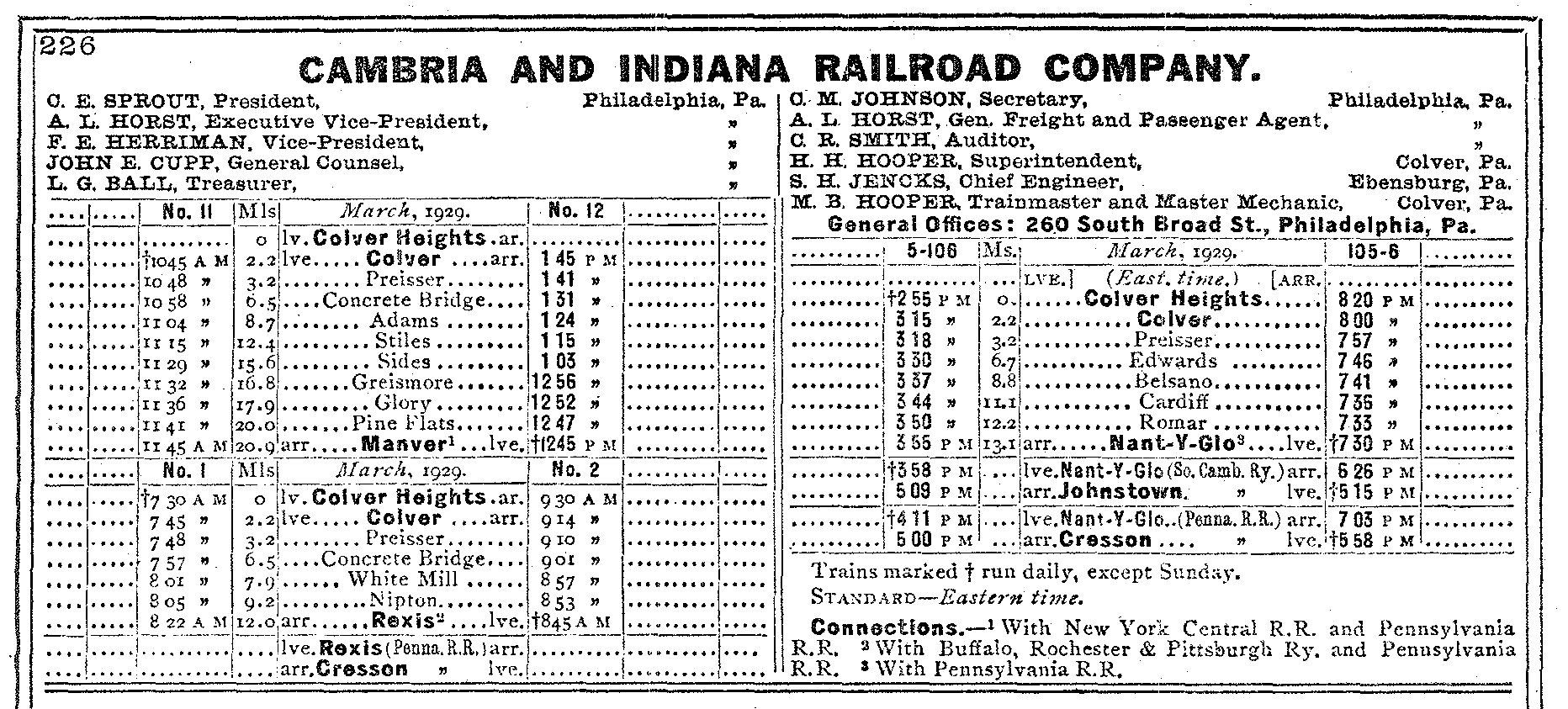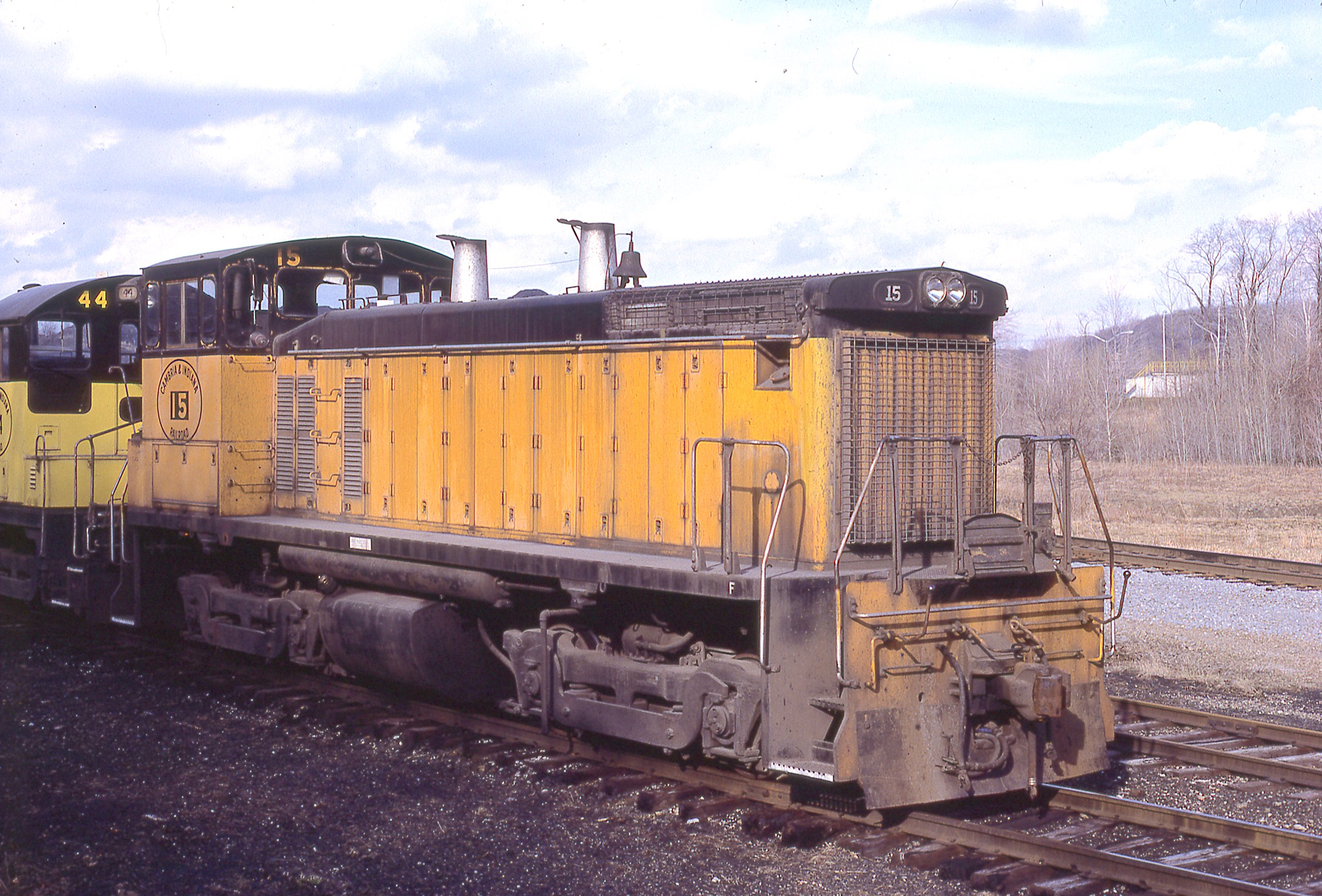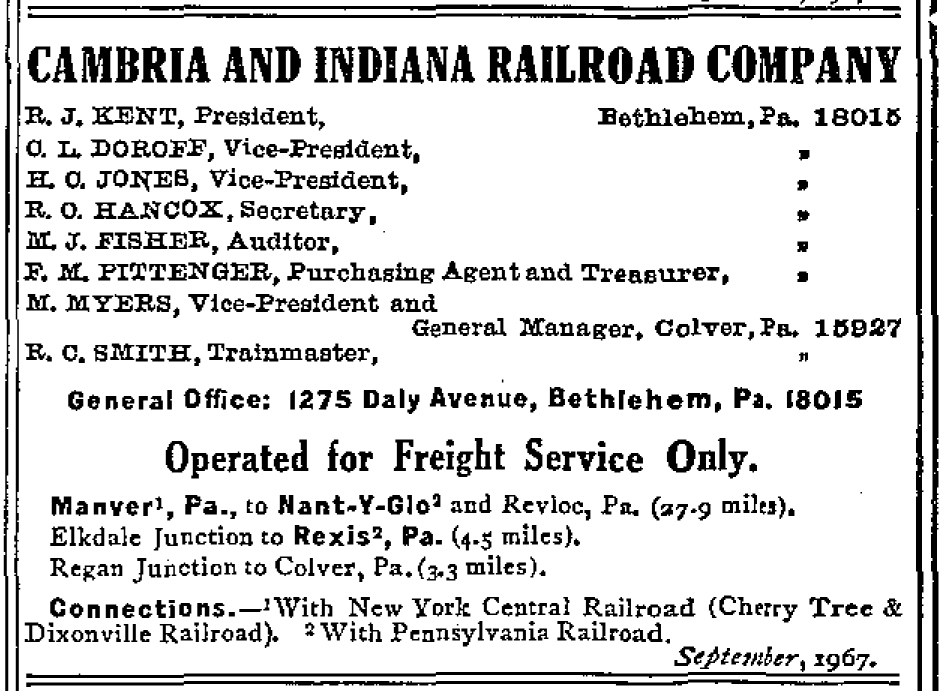Cambria and Indiana Railroad: Serving Indiana County, PA
Published: July 28, 2024
By: Adam Burns
The Cambria and Indiana Railroad (reporting mark CI) is a storied company situated in southeastern Indiana County, Pennsylvania.
Established in 1904 and operational by 1910, its original mission was to transport lumber. However, the discovery of coal in the region shortly after construction dramatically shifted its focus to the coal industry.
By harnessing the booming coal market, C&I rose to prominence in the 1930s and 1940s, earning the distinction of being the "richest railroad in the country" with the highest revenue per mile of track. At its peak, the system maintained a network of about 36 route miles.
Despite this impressive run, the advent of electricity as a primary heating source significantly impacted C&I's business. Faced with declining demand, and closing of all online coal mines, the company eventually divested nearly all of its assets in 1995.
Heritage
The Cambria and Indiana Railroad began as the Blacklick and Yellow Creek Railroad (B&YC), formed in 1904 as a subsidiary of the Vinton Lumber Company. As the name suggests, the railroad was initially tasked with transporting lumber.
However, the discovery of coal in the region soon changed everything. The operation was subsuquently cquired in 1910 by John Heisley Weaver and B. Dawson Coleman for $100,000 to serve the coal interests of Cambria and Indiana counties.
At the time of its acquisition, B&YC spanned a mere 10 miles. Rapid expansion followed, with construction commencing in February 1911, and on April 20, 1911, the company was aptly renamed to reflect its service to the two counties.
By 1919, the Cambria and Indiana Railroad (CI) was serving 23 mines in the area. Passenger services were introduced in 1914 but ceased regular operation by December 1, 1931, thereafter running intermittently until the late 1930s.
The railroad's first locomotive was a Baldwin 2-8-0, #3. The little Consolidation was later sold in January 1930. Despite the railroad becoming highly profitable by the 1930s, the rising adoption of electricity for home heating led to a decline in coal demand. By 1962, only four mines remained operational on the line.
Bethlehem Steel became the majority owner of the railroad in 1950, and the opening of BethEnergy's Mine 33 near Ebensburg in 1963, along with Barnes & Tucker's large mine at Stiles in 1965, provided a resurgence.
Timetables (March, 1929)

Decline
Unfortunately, this new customer proved a short-lived boon. Over the past 25 years, the mining industry in Cambria and Indiana counties has faced a steady decline overall, leading to the near-total disappearance of area mines and subsequently, the diminishing operations of the C&I.
Various natural and economic factors began to impact railroad in the late 1970s. In 1977, a devastating flood wreaked havoc on the Rexis Branch, resulting in its abandonment.
This branch had connected to Conrail's Blacklick Secondary, which also suffered severe damage and was abandoned between Dias, Indiana County, and Beulah, Cambria County. This abandoned right-of-way was transformed into the Ghost Town Trail, a popular destination for cyclists and walkers today.
The economic struggles of Penn Central/Conrail and Bethlehem Steel further strained C&I. Bethlehem's closure of the Lackawanna plant in Buffalo and the resultant track redundancies by Penn Central made the Manver connection obsolete.
Consequently, Conrail removed the Manver Secondary (formerly the CT&D Possum Glory branch), and C&I dismantled its tracks from Manver to Glory Crossing near Mentcle.
From the late 1970s to the mid-1980s, the cessation of operations at mines in Colver, Nanty Glo, and Stiles left Mine 33 (Cambria Slope) in Ebensburg as C&I's sole remaining regular customer. A section of the main line from Glory Crossing south to Adele Crossing near White Mill was sold to InterPower of PA, which built a co-generation plant near Colver.
In the early 1990s, C&I constructed a locomotive service facility with offices on the former Revloc mine property. This eliminated the need for a 20-mile return trip to the engine houses at Colver after servicing Mine 33, significantly reducing the use of trackage north of Revloc and the facilities at Colver.
Diesel Roster (All-Time)
| Road Number | Model | Builder | Serial Number | Completion Date | Notes |
|---|---|---|---|---|---|
| 15 | SW1500 | EMD | 34121 | 6/1968 | Became Patapsco & Back Rivers as #215. |
| 16 | SW1500 | EMD | 34122 | 6/1968 | Became Patapsco & Back Rivers as #216. |
| 17 | SW1500 | EMD | 35118 | 9/1969 | ex-Patapsco & Back Rivers #160. Later became P&BR #217, |
| 18 | SW1500 | EMD | 35119 | 9/69 | ex-P&BR #161; later became P&BR #218. |
| 19 | MP15DC | EMD | 75627-1 | 8/1975 | Became South Buffalo Railway #19. |
| 20 | MP15DC | EMD | 75627-2 | 8/1975 | Became South Buffalo Railway #20. |
| 30 | SW9 | EMD | 14508 | 7/1951 | Became P&BR #114. |
| 31 | SW9 | EMD | 14509 | 7/1951 | Became P&BR #113. |
| 32 | SW9 | EMD | 16553 | 3/1952 | Becam Philadelphia, Bethlehem & New England #93. |
| 33 | SW9 | EMD | 16554 | 3/1952 | Became P&BR #115. |
| 34 | SW9 | EMD | 16555 | 3/1952 | Became South Buffalo Railway #34. |
| 35 | SW9 | EMD | 16556 | 3/1952 | Became South Buffalo Railway #35. |
| 36 | SW9 | EMD | 16557 | 3/1952 | Became South Buffalo Railway #36. |
| 37 | SW9 | EMD | 16558 | 3/1952 | Became South Buffalo Railway #37/ |
| 38 | SW1200 | EMD | 21831 | 6/1956 | ex-Conemaugh & Black Lick #120 (1st); became Steelton & Highspire #73. |
| 39 | SW1200 | EMD | 21832 | 6/1956 | ex-C&BL 121 (1st); became S&H #74. |
| 40 | SW1200 | EMD | 22081 | 9/1956 | ex-P&BR #127; became S&H #78. |
| 41 | SW1200 | EMD | 22083 | 9/1956 | ex-P&BR #129; became PB&NE #94. |
| 42 | SW1200 | EMD | 22084 | 9/1956 | ex-S&H #44; later became S&H #75. |
| 43 | SW1200 | EMD | 21243 | 4/1956 | ex-P&BR #126; became S&H #76. |
| 44 | SW1200 | EMD | 22272 | 4/57 | ex-P&BR #134; became S&H #79. |
| 45 | SW7 | EMD | 11655 | 10/1950 | ex-Illinois Central #1217 (built as #9317); became P&BR #112. |
Final Years
The closure of Mine 33 in the summer of 1994 signaled the railroad's end. The following year, the C&I sold most of its trackage as scrap and donated much of its abandoned right-of-way to the Cambria County Conservation and Recreation Authority, which converted the land into the aforementioned Ghost Town Trail.
The C&I's remaining diesel fleet was reallocated to other Bethlehem subsidiaries. Conrail retained a small portion of the remaining tracks, and another segment was sold to a private owner. In 1998, this owner sold 9.6 miles of the abandoned track back to the C&I. Bethlehem Steel was acquired by ISG in 2003.
In 2004, nearly a decade after the closure of Mine 33 and the cessation of CI operations, ISG announced plans to reopen Mine 33 to produce coke for steelmaking and electricity by 2006. However, these plans were shelved in late 2006 due to unfavorable economic conditions.
Recent Articles
-
Indiana - Whiskey - Train Rides
Dec 23, 25 06:40 PM
Whether you're a local resident or a traveler looking to explore Indiana from a unique perspective, hopping on a whiskey train ride is a journey worth considering. -
California - Wine Tasting - Train Rides
Dec 23, 25 06:33 PM
This article explores the charm, routes, and offerings of these unique wine tasting trains that traverse California’s picturesque landscapes. -
Alabama - Wine Tasting - Train Rides
Dec 23, 25 06:26 PM
While the state might not be the first to come to mind when one thinks of wine or train travel, the unique concept of wine tasting trains adds a refreshing twist to the Alabama tourism scene.





